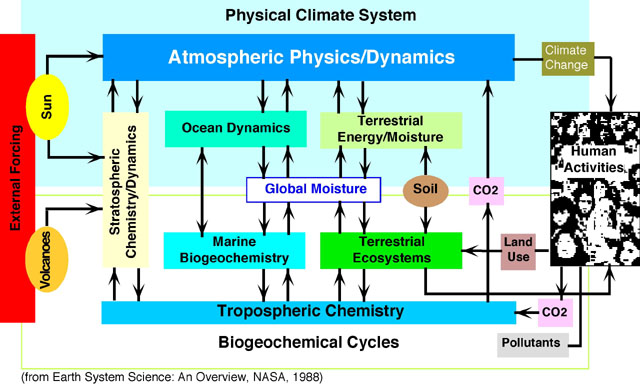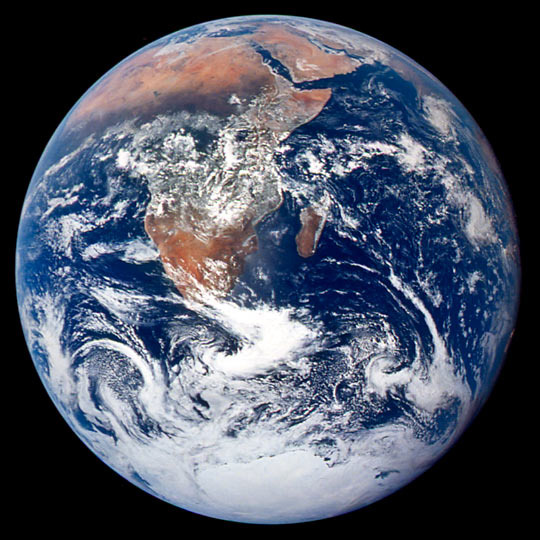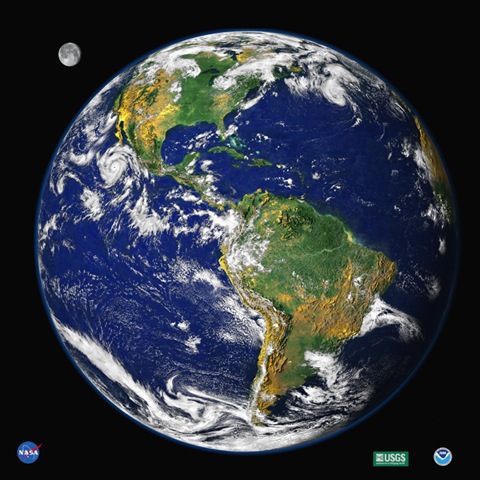
Earth System Science
The environmental conditions of earth, including the climate, are determined by physical, chemical, biological, and human interactions that transform and transport materials and energy. This is the "earth system": a highly complex entity characterized by multiple nonlinear responses and thresholds, with linkages between disparate components.
(Jickells, et al, 2005).The Earth behaves as a system in which oceans, atmosphere and land, and the living and non-living parts therein, are all connected.
( Steffen et al, 2004).
Definition
The Oxford English Dictionary defines a system as:
A set or assemblage of things connected, associated, or interdependent, so as to form a complex unity; a whole composed of parts in orderly arrangement according to some scheme or plan.
The earth system is composed of interacting physical, chemical, and biological processes that move and change materials and energy on earth. The system provides the conditions necessary for life on the planet. For example, plants, which are part of the living system, use solar energy to change carbon dioxide into organic carbon. Less carbon dioxide in the atmosphere helps cool the planet. Winds and ocean currents move heat from the tropics to higher latitudes, helping to warm the higher latitudes.
Earth systems interact through feedbacks. Positive feedbacks lead to instability. They speed up change in the system. Negative feedbacks lead to stability. They reduce change in the system. See feedbacks. Until the beginning of the Anthropocene, the systems were all natural. Now humans have begun to influence the planet, changing the operation of many systems. Because all systems are interconnected, a change in one systems influences all other systems.
Goal
The goal of earth system science is to obtain a scientific understanding of the entire earth system on a global scale by describing how its component parts and their interactions have evolved, how they function, and how they may be expected to continue to evolve on all time scales.
From Earth System Science Committee (1986). Overview, page 26.
History
Earth system science began in 1983 when the NASA Advisory Council established the Earth System Sciences Committee, which published their revolutionary report Earth System Science: A Program For Global Change in 1988. The committee, chaired by Francis Bretherton, showed for the first time how the many systems interact. The term "earth system science" was first used by Moustafa Chahine of the NASA Jet Propulsion Laboratory, during a meeting with Bretherton. Chahine noted scientists had studied the solar system for many years, now it was time to study the earth system.

A schematic diagram of the earth system proposed by the Bretherton committee, 1988.
Organizations Studying Earth Systems
The NASA report complements work by many groups that have organized programs to study earth. The primary international groups are:
- The World Climate Program, established in 1980 under the World Meteorological Organization, the International Council for Science, and, since 1993, the Intergovernmental Oceanographic Commission, seeks to develop the fundamental scientific understanding of the physical climate system and climate processes needed to determine to what extent climate can be predicted and the extent of human influence on climate.
- The Intergovernmental Panel on Climate Change, established in 1988 under the World Meteorological Organization and UNEP, seeks to assess scientific, technical and socio- economic information relevant for the understanding of climate change, its potential impacts and options for adaptation and mitigation.
- The International Geosphere Biosphere Program, established in 1987 under the International Council for Science, studies the interactions between biological, chemical and physical processes and human systems. IGBP collaborates with other programs to develop and impart the understanding necessary to respond to global change.
Each of these large organizations has many sub-panels working on various aspects of each program. Overall, tens of thousands of scientists contribute to earth-system studies.
The Science
The remainder of this page is taken almost entirely from the executive summaries of their reports, especially the report: Global Change and the Earth System: A Planet Under Pressure, IGBP Science 4 Report. For an update see Report 55 a PDF Document.
- The earth is a system that life itself helps
to control. Biological
processes interact strongly with physical and chemical processes to
create the planetary environment, but biology plays a much stronger role than previously thought in keeping earth’s environment within
habitable limits. Life, the carbon cycle, greenhouse gases in the atmosphere, and earth's surface temperature are all interrelated. - Global change is much more than climate change. It is real, it is happening now and it is accelerating. Human activities are significantly influencing the functioning of the earth system in many ways; anthropogenic changes are clearly identifiable beyond natural variability and are equal to some of the great forces of nature in their extent and impact. The changes are so large that we are entering a new geological age, the anthropocene.
- The human enterprise drives multiple, interacting effects that cascade through the earth system in complex ways. Global change cannot be understood in terms of a simple cause-effect paradigm. Cascading effects of human activities interact with each other and with local- and regional-scale changes in multidimensional ways.
- The earth’s dynamics are characterized
by critical thresholds and abrupt changes. Human activities
could inadvertently trigger
changes with catastrophic consequences for the earth system. Indeed, it appears that such a change was narrowly avoided in the case of depletion of the stratospheric ozone layer. The earth system has operated in different quasi-stable states, with abrupt changes occurring between them over the last half million years. Human activities clearly have the potential to switch the earth system to alternative modes of operation that may prove irreversible. Changes in the earth system can lead to abrupt climate change. - The earth is currently operating in a no-analogue state. In terms of key environmental parameters, the earth system has recently moved well outside the range of the natural variability exhibited over at least the last half million years. The nature of changes now occurring simultaneously in the earth system, their magnitudes and rates of change are unprecedented.
Recent Developments
Several developments have led to this dramatic change in our perception of earth:
- Blue Marble. The view of earth from space, a blue-green
sphere floating in blackness, triggers
emotional feelings of a home teeming with life
set in a lifeless void. It also leads us to ponder that we are alone
on a spaceship with limited resources.


Click on images for a zoom.
Left: Photograph of earth taken on December 7, 1972 by the crew of Apollo 17 from a distance of about 45,000 km, while traveling to the moon. This image revolutionized our concept of earth, and it is one of the most famous photographs ever taken.
Image from NASA Earth Observatory.
Right: The Blue Marble floating in the void. earth as seen from space based on a montage of data from three satellites. Clouds were observed on September 9, 1997 by the Geostationary Operational Environmental Satellite (GOES) operated by NOAA. Land color is portrayed by a vegetation index calculated using data collected from September 9-19, 1997, by the Advanced Very High Resolution Radiometer (AVHRR) instruments carried aboard NOAA's Polar Orbiting Environmental Satellites. Ocean color data were collected in late September and early October 1997 by NASA's Sea-viewing Wide Field-of-view Sensor (SeaWiFS) satellite.
Image from NASA Visualization Analysis Lab, Goddard Space Flight Center.
- Global observation systems and fleets of satellites allow us to study the earth as a whole in ways that we could do before only on regional or local scales. We can now study earth as a system.
- Global databases are now being collected and processed in a consistent way that allows us to compare and analyze processes on a global scale over many years.
- Dramatic advances in our ability to collect data about environmental conditions hundreds to millions of years ago allow contemporary processes to be viewed as continuations of past processes.
- Enhanced computing power allows us to use theory and data together to study earth and the interactions among many different parts of the earth system.
Science has crossed the threshold of a profound shift in the perception of the human-environment relationship, operating across humanity as a whole and at the scale of the earth as a single system.
Consequences
As earth's population increases, changes in the environment accelerate, leading ultimately to disasters.
Wherever humans live at high population densities, making unsustainable demands on natural systems, ... you eventually see ecological breakdowns, unmet needs, and tensions that lead toward conflict. Look at Darfur. Look at Rwanda. Look at Zimbabwe.
From Quammen (2005).
References
Earth System Science Committee (1986). Earth System Science: A Program
For Global Change. Washington DC, NASA.
Jickells, T. D., Z. S. An, et al. (2005). Global Iron Connections Between
Desert Dust, Ocean Biogeochemistry, and Climate. Science 308(5718):
67-71.
Quammen, D. (2005). Tracing the Human Footprint. National
Geographic. September 2005,
208: 2--35.
Steffen, W., A. Anderson, et al. (2004). Global
Change and the Earth System: A Planet Under Pressure, Springer.
Revised on: 29 May, 2017
